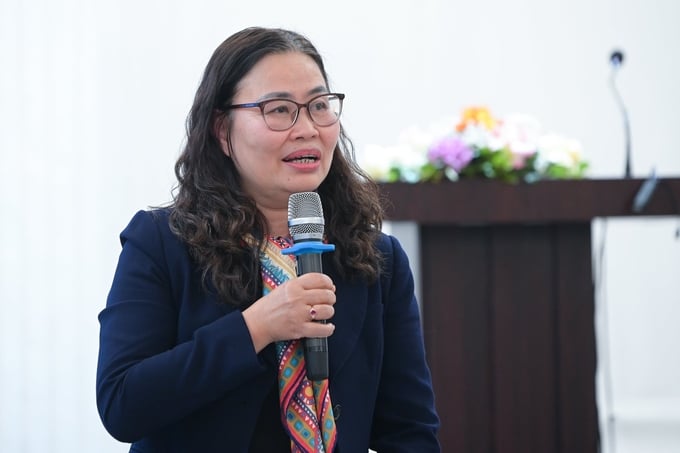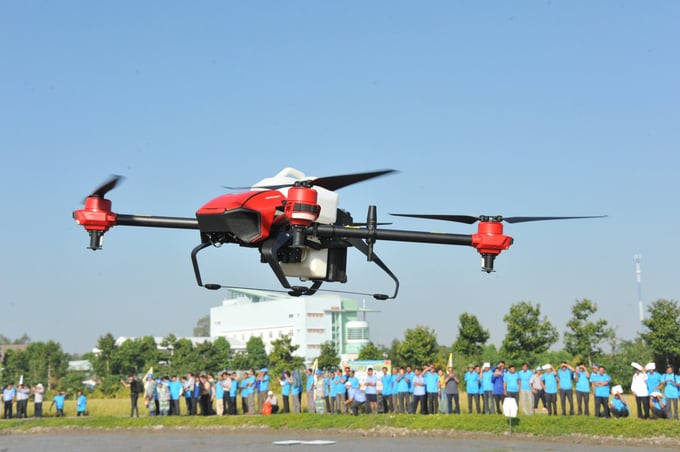November 27, 2025 | 22:02 GMT +7
November 27, 2025 | 22:02 GMT +7
Hotline: 0913.378.918
November 27, 2025 | 22:02 GMT +7
Hotline: 0913.378.918

Ms. Nguyen Thi Thanh Thuy, Director of the Department of Science, Technology, and Environment, speaking at the press conference introducing the AGRITECHNICA ASIA VIETNAM 2025 agricultural trade fair on the afternoon of February 14. Photo: Tung Dinh.
According to statistics from the Ministry of Agriculture and Rural Development (MARD), the number and types of mechanized equipment for agricultural production have been rapidly increasing, reaching relatively high levels. Specifically, mechanization in crop production has reached 70%, while in livestock farming, it is around 60%.
Vietnam currently has approximately 8,000 mechanical enterprises, nearly 300 scientific research institutions, and over 4,000 agricultural cooperatives collaborating with nearly 2,000 enterprises in agricultural production, processing, and product distribution.
However, Vietnamese agriculture still faces several limitations, such as a high proportion of small-scale production, low labor productivity, and insufficient mechanization in various sectors.
These issues were highlighted during a press conference on February 14 in Hanoi, introducing the AGRITECHNICA ASIA VIETNAM 2025 agricultural trade fair.
Additionally, delegates pointed out other weaknesses, including the slow progress in agricultural processing and deep processing in recent years. While exports of agricultural, forestry, and fishery products have steadily increased, they remain largely in raw form.
Nguyen Thi Thanh Thuy, Director of the Department of Science, Technology, and Environment (MARD), attributed this situation to relatively low levels of science and technology. The ability to apply scientific and technological advancements, as well as national and international quality standards, remains limited. Despite significant growth and high production capacity, the agricultural sector still consists of many small, fragmented fields, differing from modern agricultural systems.

Scientific and technological applications are increasingly gaining public interest and investment. Photo: Le Hoang Vu.
According to Ms. Thuy, production is important, but understanding market demands is even more crucial. Production must be market-oriented to select appropriate machinery and technological advancements.
Ms. Thuy hopes that through the exhibition in Ho Chi Minh City from March 12-14, machinery manufacturers will grasp market needs, allowing them to develop more suitable machines for future exhibitions.
"I hope that one day, Vietnamese agricultural products will be recognized worldwide as being produced with German machinery and technology", Ms. Thuy emphasized.
In the future, she wishes to strengthen cooperation among stakeholders, especially between researchers and businesses. This includes importing, transferring, and mastering technology in Vietnam - an essential solution to reducing costs and production expenses in agriculture.
Achieving this goal will enhance the quality and value of agricultural products, enabling them to enter global value chains and establish Vietnam’s national agricultural brand. It will also mobilize social resources to invest in agricultural and rural infrastructure and support services.
The Director of the Department of Science, Technology, and Environment also hopes that AGRITECHNICA ASIA VIETNAM 2025 will have a strong impact on the Mekong Delta, the country’s key agricultural production area, which accounts for 45% of Vietnam’s total agricultural, forestry, and fishery output. This region must accelerate mechanization to boost productivity, product quality, and farmers’ income.
AGRITECHNICA ASIA is the world's leading agricultural trade fair organized by DLG, building on the legacy of AGRITECHNICA in Hannover, Germany, which has been showcasing agricultural technology since 1985.
AGRITECHNICA ASIA VIETNAM 2025 will take place from March 12-14 at the Saigon Exhibition and Convention Center (SECC) in Ho Chi Minh City. Vietnam Agriculture Newspaper is the official media sponsor.
Translated by Kieu Chi

(VAN) On November 27, in the meeting with Minister Tran Duc Thang, Mayor Yin Yong shared Beijing’s experience to improve environment and air quality.

(VAN) After 30 years, both sides identified strategic areas of cooperation: sustainable production, increasing coffee value and training for farmers.
/2025/11/27/4910-4-164708_294.jpg)
(VAN) On the afternoon of November 27 in Beijing, Minister of Agriculture and Environment Tran Duc Thang held a working session with several major Chinese enterprises operating in the agriculture and environment sector.

(VAN) The Department of Animal Health issued a provisional guideline requesting local authorities to increase surveillance, collect samples for testing, and conduct epidemiological investigations according to the established procedure.

(VAN) The United Nations recommends that Vietnam utilize data and artificial intelligence to enhance early disaster warnings and reduce GDP losses by 3.2% in the context of climate change.

(VAN) On the morning of November 27 in Beijing, Minister Tran Duc Thang and the Deputy Commissioner General of the General Administration of Customs of China signed a protocol on fresh jackfruit exports.

(VAN) As floodwaters recede, a vast network of irrigation works across eastern Gia Lai is emerging in a state of severe disrepair, with extensive damage demanding urgent restoration ahead of the 2025-2026 winter-spring cropping season.